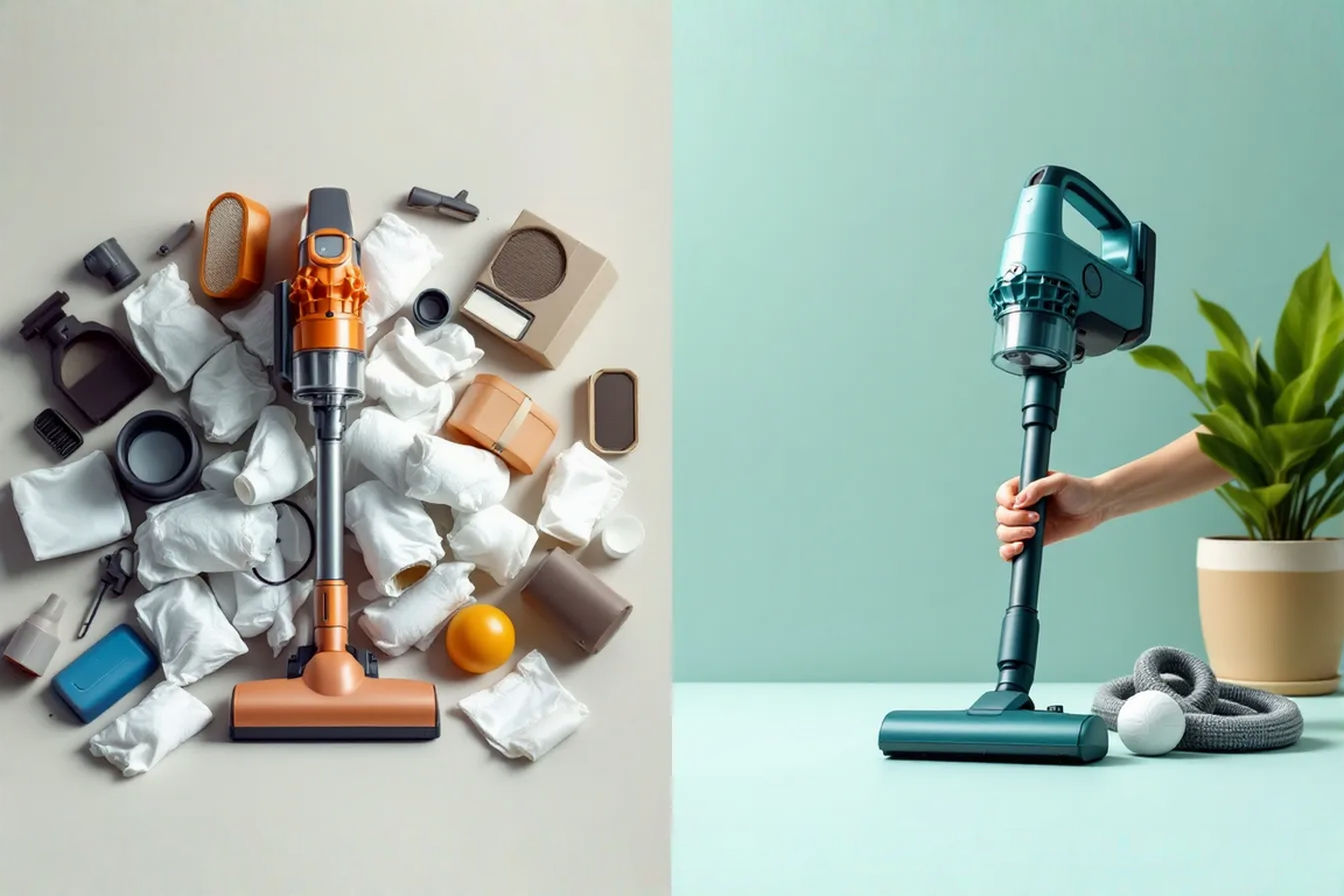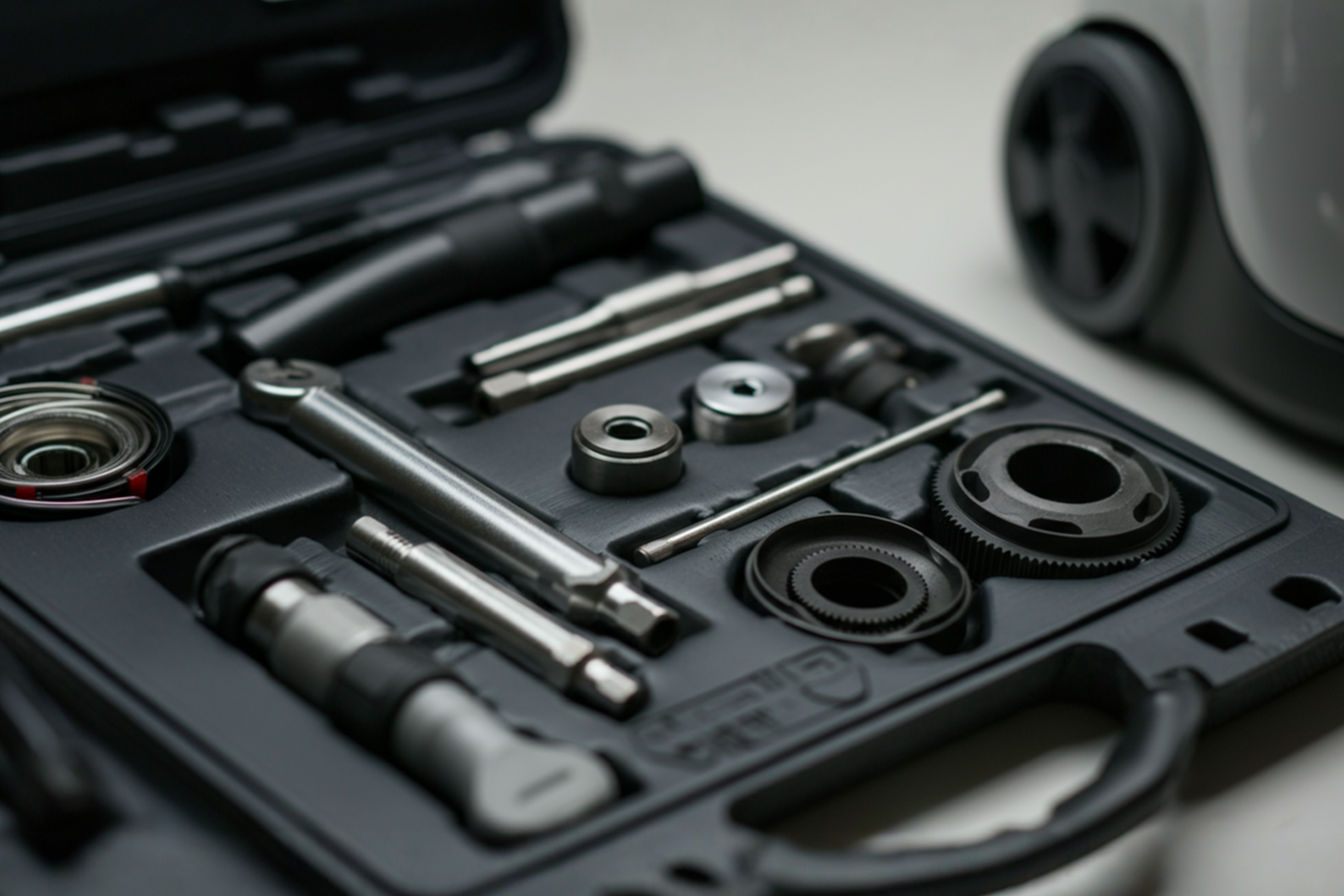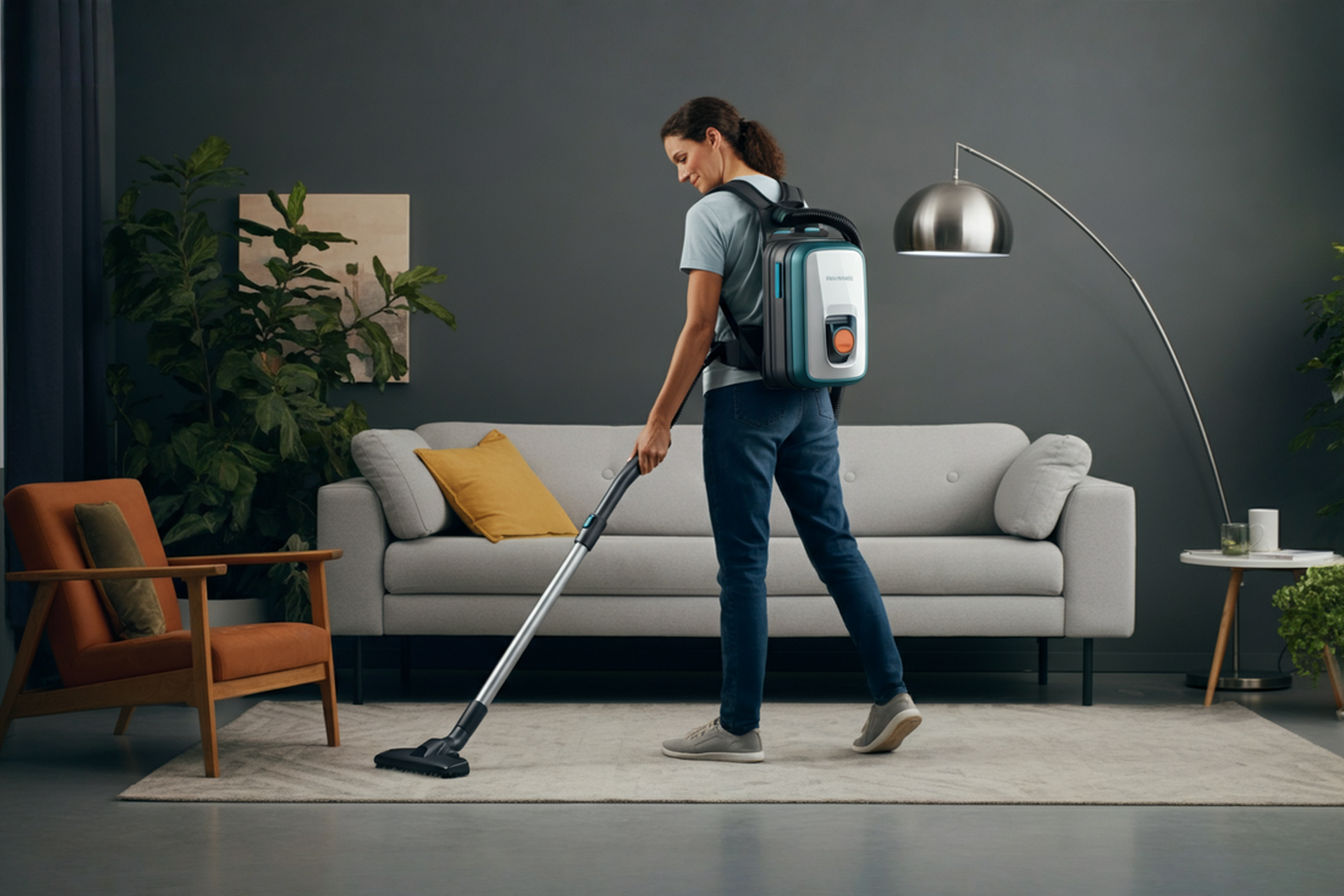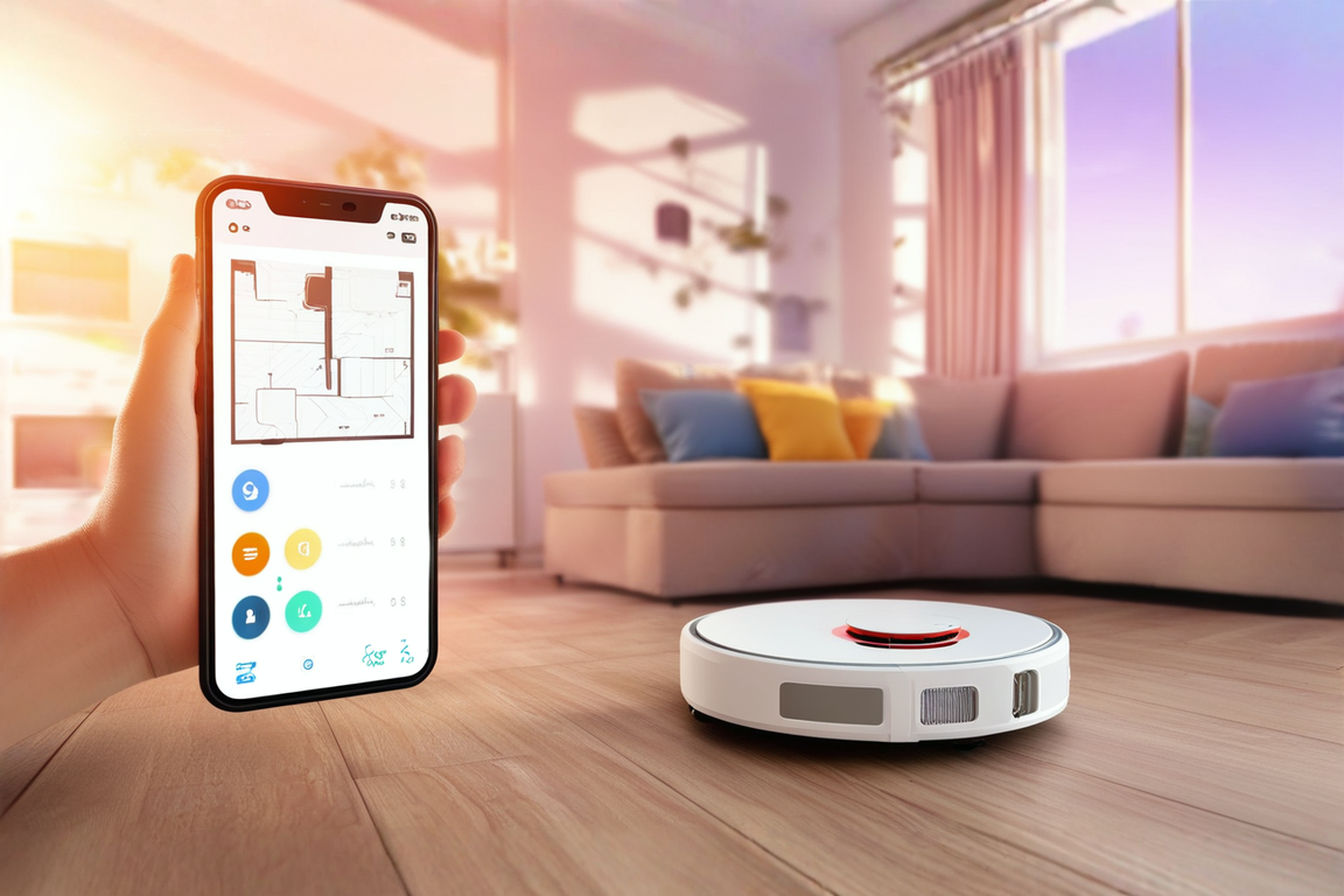Hand Tool Ecosystem: Developing a Collection for Spaces Too Small for Vacuums
Traditional vacuums don’t work in tight quarters? Develop a specialized ecosystem of hand tools that clean effectively while saving space. Perfect for tiny homes, apartments, and off-grid living.
This post may contain affiliate links. If you make a purchase through these links, we may earn a commission at no additional cost to you.
Living in a compact space brings unique challenges, especially when it comes to cleaning and maintenance. Traditional vacuum cleaners—with their bulky profiles, cord management issues, and storage requirements—often prove impractical in tiny homes, studio apartments, RVs, or dorm rooms. Yet maintaining cleanliness remains essential for comfort and health.
The solution lies in developing a thoughtfully curated ecosystem of manual cleaning tools that work together to tackle every cleaning challenge without requiring the space, power, or noise of conventional vacuums. This comprehensive approach transforms cleaning from a frustrating chore into an efficient practice perfectly adapted to your limited square footage.
By assembling the right collection of hand tools, you gain versatility, accessibility, and effectiveness without sacrificing precious space. Each tool serves a specific purpose while complementing others in your arsenal, creating a complete cleaning system that rivals the convenience of larger appliances. This guide explores how to build, maintain, and optimize your hand tool ecosystem for small-space living where vacuums simply aren’t a practical option.
Understanding the Small Space Cleaning Challenge
Space Constraints: When Vacuums Simply Don’t Fit
The primary obstacle in compact living environments isn’t just the floor space a vacuum occupies during use, but the storage footprint it demands when idle. Even modern “slim” vacuum models require dedicated closet space—a luxury many small dwellings can’t afford. Wall-mounted options need permanent installation, while canister models include hoses and attachments that create storage complications.
The issue extends beyond the physical dimensions of the appliance itself. Maneuverability becomes problematic when navigating around furniture in tight quarters, making the cleaning process awkward and potentially damaging to walls and furniture. Manual cleaning tools, by contrast, offer precision without the bulk, allowing access to confined areas that would defeat even the most compact vacuum designs.
Noise Considerations in Shared and Compact Living
Sound travels differently in small spaces, amplifying even moderately noisy appliances to disruptive levels. This creates particular challenges in shared living situations, dorms, or any environment where noise pollution affects others. Traditional vacuums operate at 70-80 decibels—equivalent to a busy restaurant or passing highway traffic—making them problematic for those with roommates, sleeping children, or noise-sensitive neighbors.
Hand tools eliminate this acoustic disruption entirely. The ability to clean quietly at any hour provides flexibility for those with non-standard schedules or in close-quarter living arrangements. This silent operation transforms cleaning from a scheduled event that must accommodate others into a casual maintenance task that can be performed whenever convenient.
Power and Outlet Limitations in Alternative Living Spaces
Many alternative living arrangements face electrical constraints unfamiliar to conventional homes. Tiny houses operating on solar power systems must carefully manage energy consumption. RVs and boats often rely on limited battery reserves or shore power connections. Even standard apartments sometimes feature inconveniently placed outlets that necessitate awkward cord management while cleaning.
Manual cleaning tools sidestep these limitations entirely. Their electricity-free operation ensures consistent performance regardless of power availability—perfect for off-grid scenarios or spaces with minimal electrical infrastructure. This independence from outlets creates cleaning flexibility impossible to achieve with conventional vacuum cleaners.
Storage Dilemmas: Where to Keep Your Cleaning Tools
Storage represents perhaps the most significant advantage manual tools hold over vacuums in compact environments. A complete hand tool collection can fit within a single cabinet, wall-mounted rack, or even a dedicated container that slides under furniture. This compact storage profile preserves precious space for living rather than housing cleaning equipment.
Additionally, hand tools typically weigh significantly less than even the lightest vacuums, making them easier to access from higher storage locations. Their modular nature allows for creative storage solutions adapted to your specific space constraints—options simply unavailable with one-piece vacuum cleaners.
Core Hand Tools: Building Your Foundation
The Essential Dustpan and Brush Duo
The cornerstone of any manual cleaning collection begins with a quality dustpan and brush set. This fundamental pairing handles everything from quick cleanups to comprehensive floor maintenance. When selecting this essential duo, prioritize dustpans with rubber edges that create a tight seal against flooring surfaces—preventing the frustrating line of dust that often remains after sweeping.
The most versatile dustpans include both standing and handheld configurations, eliminating the need to bend repeatedly during cleaning sessions. Look for models featuring built-in combs for brush cleaning, dust-lock ridges to prevent spillback, and hanging holes for vertical storage. Combined with a proper brush, this tool handles most everyday debris collection without requiring electrical power.
The accompanying brush deserves equal consideration. Angled bristles reach into corners more effectively than straight-cut alternatives, while synthetic materials typically outperform natural fibers in durability and debris capture. Some premium models feature dual-textured bristles—stiffer outer bristles for larger debris and softer inner bristles for finer particles—providing comprehensive cleaning in a single tool.
Hand Brooms: Versatility for Multiple Surfaces
While often confused with dustpan brushes, dedicated hand brooms serve a distinct and crucial role in your manual cleaning ecosystem. These short-handled implements feature denser bristle patterns designed specifically for agitating debris embedded in textured surfaces like carpet edges, upholstery, and area rugs—places where dustpan brushes prove ineffective.
The best hand brooms incorporate ergonomic handles that reduce wrist strain during extended use. Models with replaceable heads provide economic advantages while reducing environmental impact. Specialty variations include rubber-bristled options that excel at removing pet hair from textiles—a challenge that frustrates many vacuum users even with dedicated attachments.
For optimal versatility, select a hand broom with medium-stiff bristles capable of working across multiple surface types. Extremely rigid bristles can damage delicate fabrics, while overly soft versions fail to dislodge stubborn particles. The ideal balance provides effective cleaning across your entire living space without requiring multiple specialized tools.
Manual Carpet Sweepers: The Vacuum Alternative
For homes with significant carpeted areas, manual carpet sweepers offer the closest functional equivalent to powered vacuums. These ingenious devices use rolling brushes activated by pushing the tool across flooring surfaces. The mechanical action captures debris in an internal compartment without requiring electricity, providing efficient cleaning with minimal effort.
Modern carpet sweepers have evolved significantly from their historical counterparts. Contemporary models feature dual rotating brush systems, easy-empty canisters, and edge brushes that reach into corners and along baseboards. Many designs work equally well on hard floors and carpets, making them genuinely versatile tools worth their modest storage footprint.
The primary advantage of quality carpet sweepers lies in their cleaning efficiency-to-size ratio. A tool roughly the dimensions of a standard shoe box provides cleaning power approaching that of much larger vacuum units, particularly for surface-level debris. While they don’t match the deep-cleaning capability of powered vacuums, regular maintenance with a manual sweeper significantly extends the time between more intensive cleaning sessions.
Microfiber Tools: Dust Management Without Electricity
Microfiber technology has revolutionized dust control in ways particularly beneficial to small-space dwellers. These specialized fabrics feature microscopic fibers that create both mechanical and electrostatic attraction to dust particles, capturing and retaining debris without requiring sprays, electricity, or complex mechanisms.
The most versatile microfiber implementation comes in flat mop systems with swiveling heads and washable, replaceable pads. These tools clean walls, ceilings, and floors with equal effectiveness, reaching under furniture that would stymie traditional cleaning methods. Their lightweight design and minimal storage requirements make them ideal for compact living environments.
Supplementary microfiber products like dusting mitts, cloths, and wands extend this technology to furniture, electronics, and decorative items. The reusable nature of these tools aligns perfectly with sustainable living principles common in tiny homes and alternative housing. A comprehensive microfiber collection often replaces multiple conventional cleaning products while occupying minimal storage space.
Specialized Tools for Different Surfaces
Hard Floor Solutions: Beyond the Broom
Hard flooring surfaces benefit from specialized manual tools that outperform traditional alternatives. The humble dust mop has evolved significantly, now incorporating microfiber technology that eliminates the problematic dust redistribution common with older cotton versions. Flat mops with spray reservoirs combine liquid cleaning with physical debris removal, providing comprehensive maintenance without buckets or electricity.
For textured hard surfaces like tile, manual scrubbing brushes with extended handles eliminate the need for powered floor scrubbers. Models featuring water-reservoir handles dispense cleaning solution as needed, while those with abrasive pads tackle stubborn grime without damaging underlying surfaces. The compact profile of these specialized tools allows for vertical storage in narrow utility closets or behind doors.
Dedicated edging tools address the challenging transitions between flooring and walls or cabinetry—areas where dirt accumulates beyond the reach of broader cleaning implements. Simple hand-powered edge cleaners with flexible heads conform to baseboard contours, extracting built-up debris from these neglected zones without requiring the attachments and hoses of conventional vacuums.
Carpet and Rug Maintenance Without Vacuum Power
Contrary to popular belief, carpets and rugs can be effectively maintained without electrical suction. Beyond the previously mentioned carpet sweepers, several specialized manual tools address the unique challenges of textile flooring. Carpet rakes with stiff tines lift embedded pet hair and refresh matted fibers, particularly in high-traffic areas where compression occurs.
Rubber brooms prove remarkably effective at gathering pet hair from carpeted surfaces—often outperforming vacuum attachments designed specifically for this purpose. Their static-generating properties cause hair to clump for easy removal, while the squeegee-like action works equally well on hard floors, making them true multi-surface performers.
For deep cleaning without machinery, carpet beaters provide traditional effectiveness in compact form. These manually operated implements dislodge embedded particles that rise to the surface for removal with brushes or sweepers. While labor-intensive compared to powered alternatives, they require minimal storage space while delivering impressive results, particularly on area rugs that can be taken outdoors.
Furniture and Upholstery: Effective Manual Methods
Upholstered furniture presents unique cleaning challenges in small spaces. Specialized upholstery brushes feature short, stiff bristles arranged in compact heads that reach into seams and crevices. The best versions include dual-sided functionality—bristles for debris loosening on one side and lint-capturing fabric on the reverse, providing comprehensive fabric maintenance in a single tool.
Fabric combs address pilling and pet hair with specially designed teeth that extract embedded material without damaging underlying textiles. These simple, palm-sized tools require virtually no storage space while delivering targeted cleaning impossible with bulkier implements. Their effectiveness on everything from couches to clothing makes them extraordinarily versatile additions to your manual cleaning arsenal.
For delicate upholstery, specialized lint rollers with variable-tack sheets remove dust and hair without stressing fabrics. Refillable models reduce waste compared to disposable alternatives, while folding handles minimize their storage footprint. Combined with occasional treatment using fabric freshening sprays, these tools maintain upholstery condition comparable to vacuum-cleaned furniture.
Crevice and Detail Cleaning Implements
The final frontier of comprehensive cleaning involves the narrow spaces and small details that even vacuum attachments struggle to address properly. Specialized crevice brushes with long, flexible bristles reach into heating vents, window tracks, and appliance gaps—areas that harbor surprising amounts of dust and debris in small living environments.
Detailing kits borrowed from automotive care provide perfect solutions for electronics, decorative items, and architectural features. These typically include various brush profiles, microfiber tips, and precision cleaning heads that access intricate components without damage. Their remarkable versatility makes them indispensable for maintaining everything from computer keyboards to decorative moldings.
For the narrowest spaces, compressed air devices with manual pumps offer electrical-free alternatives to canned air products. These reusable tools direct precise air streams into extremely tight spaces, dislodging dust from electronics and intricate objects. Their sustainable nature aligns perfectly with the minimalist principles often embraced by small-space dwellers.
Task-Specific Tools for Small-Scale Cleaning
Desktop and Workspace Cleaning Essentials
Productivity areas generate distinct messes requiring dedicated solutions. Miniature desktop dust brushes with soft bristles safely clean sensitive electronics while removing everyday dust buildup. The best versions feature telescoping handles that extend reach without increasing storage requirements—perfect for accessing rear portions of desks positioned against walls.
Keyboard cleaners ranging from simple brushes to putty-like compounds extract debris from between keys without risking internal damage. Reusable options provide economic advantages over disposable alternatives while maintaining consistent performance. When paired with microfiber cloths for screen maintenance, these tools create a complete system for technology care.
Paper management generates significant mess in work areas. Manual desktop vacuums operated by hand pumps capture paper particles and eraser dust without electrical requirements. These palm-sized tools store within desk drawers, providing immediate access without contributing to visual clutter in compact workspaces.
Kitchen Counter and Cooking Area Solutions
Food preparation zones benefit from specialized manual cleaning implements. Countertop crumb sweepers with precision edges gather cooking debris more effectively than conventional brushes. Models with built-in dustpans minimize transfer mess, while magnetic versions attach to refrigerators for instantaneous accessibility during cooking sessions.
Stovetop cleaning requires heat-resistant bristles and scraping edges that remove cooked-on residue without damaging surfaces. Dedicated cooktop brushes address these needs while occupying minimal drawer space. When combined with microfiber cloths for final polishing, these tools maintain cooking areas without the awkward maneuvering of vacuum hoses.
For comprehensive counter maintenance, mini table sweepers featuring roller brushes provide quick cleanup after meal preparation. Their mechanical operation captures fine particles like flour and sugar that might elude traditional brushing. The self-contained nature of these tools eliminates the need for separate dustpans, further conserving precious kitchen storage.
Bathroom Maintenance Without Bulky Equipment
Bathroom spaces feature unique cleaning challenges, particularly in small-scale environments. Manual squeegees with narrow profiles prevent shower mold while folding for compact storage—addressing preventative maintenance that vacuums can’t handle. Paired with microfiber cloths for broader surface cleaning, they create comprehensive solutions for moisture management.
Specialized grout brushes with angled bristles access the most problematic bathroom surfaces without requiring electrical scrubbers. Models with replaceable heads provide extended service life while maintaining optimal cleaning effectiveness. Their precision application eliminates the overspray and mess common with powered alternatives.
For fixture detailing, dental-inspired tools featuring narrow profiles and specialized tips clean seams around faucets, drains, and hardware—areas that harbor surprising amounts of biofilm and residue. These precision implements access spaces even the smallest vacuum attachments can’t reach, completing your bathroom maintenance capability without electrical requirements.
Entryway and High-Traffic Area Tools
Transition zones between outdoors and living spaces generate disproportionate debris volumes requiring immediate attention. Dedicated boot brushes with rigid bristles remove larger particles before they enter your living environment. Wall-mounted versions conserve floor space while providing convenient access precisely where needed.
For quick floor maintenance, compact sweeper sets combining brush and dustpan in integrated designs provide one-handed operation perfect for daily touch-ups. Models that stand independently eliminate the need to bend during cleanup sessions, while those with magnetized components attach to metal doors or appliances for storage without consuming shelf space.
Door mats with cleaning functionality trap debris at entry points before it spreads throughout your home. Specialized designs featuring multiple textures progressively remove particles from footwear through simple mechanical action. While not tools in the conventional sense, these passive cleaning elements significantly reduce the frequency of more intensive maintenance.
Compact Electric Alternatives: When Hand Tools Need Assistance
Battery-Powered Mini Vacuums Worth Considering
Despite the focus on manual tools, certain scenarios benefit from limited electrical assistance. Battery-powered handheld vacuums have evolved dramatically, with modern lithium-ion models providing impressive suction in remarkably compact packages. Units weighing less than two pounds now deliver cleaning power approaching corded alternatives while maintaining minimal storage requirements.
The most versatile options feature multiple attachments addressing various surface types and cleaning challenges. Look for models with washable filters to eliminate ongoing replacement costs and USB charging capability that eliminates the need for dedicated charging bases or proprietary adapters. These features maximize utility while minimizing the spatial impact of incorporating limited electrical assistance.
For optimal integration with your manual ecosystem, select units specifically designed for spot cleaning rather than comprehensive maintenance. This targeted application preserves battery life while addressing the specific scenarios where manual tools prove less effective—particularly in extracting deeply embedded debris from textured upholstery or vehicle interiors.
Cordless Stick Vacuums for Small Spaces
When larger floor areas require more intensive cleaning, ultra-slim cordless stick vacuums provide an attractive compromise between full-sized vacuums and manual tools. Modern versions feature wall-mounting storage solutions that minimize floor space requirements while maintaining accessibility. Detachable handheld units within these systems deliver multiple cleaning functions in a single device.
The primary advantage of quality stick vacuums lies in their ability to convert between configurations based on cleaning requirements. Their modular design allows for customized performance matching specific tasks—from brief touch-ups to more comprehensive maintenance sessions. This adaptability proves particularly valuable in spaces too small for multiple specialized electrical appliances.
Battery technology represents the critical consideration when selecting these tools. Units featuring removable battery packs allow for extended cleaning without waiting for recharging, while those with rapid charging capabilities minimize downtime between sessions. These features prove particularly important in off-grid environments where power access may be limited or intermittent.
USB-Powered Desktop Cleaners
For technology-focused environments, USB-powered mini vacuums provide targeted cleaning for keyboards, computer towers, and electronic equipment. These specialized tools draw minimal power while delivering surprisingly effective debris extraction from sensitive components. Their direct connection to computers eliminates battery management concerns while providing cleaning exactly where most needed.
The best implementations feature multiple attachment heads addressing different equipment profiles and cleaning requirements. Flexible extensions reach into confined spaces between components, while brush attachments safely agitate debris without risk to underlying electronics. Their minimal size allows for storage within desk drawers or computer bags for immediate accessibility.
While limited in broader application, these tools provide essential functionality in workspaces where electronic debris represents a primary cleaning concern. Their specialized nature complements rather than replaces your core manual tools—addressing specific scenarios where hand implements might prove less effective or potentially damaging to sensitive equipment.
When to Supplement Manual Tools with Electric Options
The decision to incorporate electrical assistance should focus on specific cleaning challenges rather than general preference. Analyze your living environment for scenarios where manual tools consistently underperform or require excessive effort. These pain points indicate potential applications for limited electrical assistance while preserving your primarily manual ecosystem.
Pet ownership often justifies targeted electrical supplements, particularly for homes with shedding animals on upholstered furniture. Deep pile carpets similarly benefit from occasional powered extraction beyond what manual carpet sweepers can achieve. Both scenarios maintain overall commitment to manual cleaning while acknowledging the practical limitations of completely electricity-free approaches.
For optimal integration, select electrical tools that complement rather than duplicate your manual capabilities. This strategic approach preserves storage space while maximizing overall cleaning effectiveness across your entire living environment. The resulting hybrid system combines the advantages of both approaches while minimizing their respective limitations.
Building a Complete Ecosystem: Strategic Collection Development
Assessing Your Specific Space and Cleaning Needs
Developing an effective hand tool ecosystem begins with a thorough assessment of your unique living environment. Start by cataloging the surfaces present in your space—noting floor types, furniture materials, and architectural features that require regular maintenance. This inventory reveals the specific cleaning challenges your collection must address.
Next, analyze your typical mess patterns. Pet owners face different challenges than those without animals. Cooking enthusiasts generate distinct debris compared to minimal kitchen users. Note where messes commonly occur and their composition, as these factors directly influence your tool selection priorities. This personalized approach ensures your collection addresses real-world needs rather than hypothetical scenarios.
Consider your mobility and physical capabilities when planning your ecosystem. Those with limited bending ability might prioritize tools with extended handles, while individuals with grip strength concerns benefit from ergonomic designs. These practical considerations prove equally important as cleaning effectiveness when building a sustainable maintenance routine.
Finally, document storage opportunities throughout your space. Look beyond conventional closets to identify potential tool housing locations—behind doors, alongside furniture, or mounted on walls. This spatial awareness guides acquisitions toward items that fit available storage while providing necessary functionality. The resulting customized approach maximizes effectiveness while minimizing spatial impact.
Prioritizing Versatility: Multi-Purpose Tools
In compact living environments, each tool must justify its storage footprint through exceptional utility. Multi-function implements deliver particular value by addressing multiple cleaning challenges with minimal spatial impact. Telescoping handles that adjust to various heights transform single tools into multiple cleaning solutions adaptable to different scenarios.
Convertible designs offer similar advantages through reconfigurable components. Systems featuring interchangeable heads on standard handles allow for customized cleaning approaches without redundant parts. This modular philosophy maximizes functional variety while minimizing storage requirements—an ideal balance for space-constrained environments.
When evaluating potential additions to your ecosystem, consider the range of applications rather than single-purpose effectiveness. A slightly less efficient tool that addresses multiple scenarios typically provides greater overall value than a specialized implement with limited application. This versatility-focused approach builds remarkable cleaning capability without overwhelming your storage capacity.
Creating a Modular System That Grows with Your Needs
Rather than acquiring all potential tools simultaneously, develop your collection gradually based on demonstrated needs. Begin with fundamental implements addressing your most common cleaning challenges—typically a quality dustpan and brush set, microfiber cloths, and hand broom. This foundation handles most routine maintenance while you identify specific areas requiring specialized solutions.
As you use these core tools, note scenarios where they prove inadequate or require excessive effort. These friction points reveal natural expansion opportunities for your collection. By growing through identified needs rather than presumptive purchasing, you avoid accumulating unnecessary implements that consume precious storage space without delivering proportional benefits.
Maintain consistent mounting or connection systems when expanding your collection. Tools using standardized handle fittings can share extensions and accessories, reducing overall part count while increasing functionality. This standardization creates natural synergies between implements while simplifying storage and maintenance considerations.
Storage Solutions for Your Hand Tool Collection
Effective storage transforms a collection of individual implements into a cohesive cleaning system. Wall-mounted organizers with designated tool positions provide immediate visibility and access while consuming zero floor space. Look for designs featuring adjustable grips accommodating various handle diameters to maximize compatibility with your diverse collection.
For portable solutions, cleaning caddies with divided compartments keep related tools together while facilitating transport between rooms. The best implementations include drainage features preventing moisture accumulation from damp implements, extending tool lifespans while maintaining hygienic storage conditions. Their consolidated nature simplifies retrieval and return, encouraging consistent cleaning practices.
Vertical storage maximizes space efficiency in particularly constrained environments. Specialty racks utilizing door backs, cabinet interiors, or narrow wall sections convert otherwise unused spaces into functional storage. These purpose-built solutions ensure each tool remains accessible without contributing to environmental clutter—maintaining the open, uncluttered aesthetic central to successful small-space living.
Maintenance and Care of Your Hand Tool Ecosystem
Cleaning Your Cleaning Tools: Essential Practices
Effective cleaning implements require regular maintenance to preserve functionality and hygiene. Establish consistent cleaning routines for your tools to prevent cross-contamination and performance degradation. Brushes benefit from weekly debris removal and monthly washing to prevent bristle damage and bacterial growth, while microfiber requires special laundering techniques to maintain electrostatic properties.
For bristle-based tools, create a simple cleaning station using a wide-tooth comb secured over a small container. This arrangement allows for quick debris removal between uses without additional tools or mess. More thorough cleaning involves mild soap solutions and complete drying before storage—preventing mildew development while preserving bristle arrangement and effectiveness.
Microfiber products demand particular attention to maintain their exceptional performance characteristics. Wash separately from conventional textiles using minimal detergent and no fabric softeners, which coat fibers and reduce dust-capturing capabilities. Air drying preserves the microscopic structure responsible for their cleaning effectiveness, significantly extending useful lifespan compared to machine drying.
Extending Tool Lifespan Through Proper Care
Beyond regular cleaning, several practices dramatically extend tool serviceability. Proper storage preventing bristle deformation represents the most significant factor in brush longevity. Hanging implements with bristles downward allows gravity to maintain proper shape while facilitating complete drying between uses—preventing the internal moisture that accelerates deterioration.
For tools with moving parts like carpet sweepers, periodic lubrication maintains smooth operation while preventing premature wear. Food-grade silicone provides ideal protection without creating sticky residues that attract additional dirt. This minimal maintenance significantly extends functional lifespan while ensuring consistent performance throughout the tool’s service life.
UV exposure represents a particular threat to synthetic components in cleaning tools. Store implements away from direct sunlight to prevent material degradation and color fading. This simple precaution preserves both functionality and appearance, particularly for plastic components that become brittle with extended solar exposure. The resulting longevity reduces replacement frequency while maintaining consistent cleaning effectiveness.
DIY Repairs and Modifications for Better Performance
Many common tool issues respond well to simple repairs that extend functional lifespan. Loose handles benefit from reinforcement with food-grade epoxy or specialized tool adhesives—restoring structural integrity without replacing the entire implement. These straightforward fixes maintain familiar, effective tools while reducing ongoing replacement costs.
Bristle tools sometimes develop splayed patterns that reduce cleaning effectiveness. Soaking bristle ends in warm water followed by reshaping and restricted drying restores original configurations without replacement. This reconditioning process works particularly well for natural fiber brushes that respond to moisture manipulation, though synthetic versions benefit from similar treatment.
Creative modifications often enhance factory designs for specific applications. Adding cord loops to handles facilitates vertical storage, while applying textured grip tape improves control for users with dexterity limitations. These personalized adjustments transform standardized tools into customized implements perfectly adapted to your particular needs and environment.
When to Replace vs. When to Repair
Despite diligent maintenance, all tools eventually require replacement. Recognize key indicators signaling the end of serviceable life: bristles worn below half their original length, structural cracks in critical components, or mechanisms that no longer operate smoothly despite maintenance. These conditions significantly impact cleaning effectiveness while potentially creating additional work through poor performance.
Develop a replacement schedule for consumable elements within your ecosystem—particularly microfiber cloths and detachable cleaning pads that experience constant friction during use. Rotating these components before complete failure maintains consistent cleaning effectiveness while allowing reasonable budgeting for ongoing maintenance costs.
When considering replacement, evaluate whether the original tool design optimally addressed your needs or if alternative configurations might provide better results. This reflective process transforms eventual replacement from simple duplication into thoughtful ecosystem evolution, continuously improving your cleaning capability without expanding storage requirements.
Real-World Applications: Hand Tool Systems for Different Living Situations
Tiny Home Hand Tool Configurations
The extreme space limitations of tiny homes demand particularly thoughtful tool curation. Focus on implements with multiple functions—extendable dusters that convert to gap cleaners, combination dustpan-broom units with minimal storage profiles, and collapsible options that compress when not in use. This concentrated approach maximizes cleaning capability while consuming minimal storage space.
Wall storage becomes essential in these environments, with vertical organization systems keeping tools accessible without floor footprint. Magnetic strips accommodate metal components, while specialized holders secure items with plastic or wooden elements. The resulting visual organization transforms necessary implements into practical wall decor—addressing both aesthetic and functional considerations.
The most successful tiny home systems emphasize daily maintenance over intensive periodic cleaning. Quick-access tools encourage immediate response to small messes before they spread or settle. This preventative approach maintains cleanliness with minimal effort while eliminating the need for more aggressive tools that consume additional storage space.
Dorm Room and Small Apartment Solutions
Shared housing situations present unique cleaning considerations beyond space constraints. Tool selection should emphasize quiet operation for late-night or early-morning cleaning without disturbing roommates. Soft-bristle options and fabric-based implements provide this acoustic advantage while maintaining effective cleaning capability for routine maintenance.
Storage potential differs significantly from tiny homes, with under-bed spaces often providing substantial capacity without consuming visible room area. Long, flat containers designed specifically for these locations accommodate full cleaning kits including extended handles and larger implements impossible in more vertically constrained environments.
Communal living particularly benefits from cleaning stations—designated locations containing all necessary tools for quick maintenance. These prepared kits encourage consistent cleaning by eliminating the friction of gathering implements from multiple storage locations. The resulting convenience transforms cleaning from a major undertaking into a simple, routine activity.
RV and Boat Cleaning Without Shore Power
Mobile living environments face additional challenges around water conservation and power independence. Dry cleaning tools naturally excel in these conditions, with mechanical carpet sweepers and microfiber systems providing effective maintenance without electrical requirements or liquid consumption. Their independence from external resources ensures consistent cleanliness regardless of connection status.
Compact storage becomes particularly critical in these environments, where every cubic inch serves multiple competing needs. Nesting tools—those designed to fit inside one another when not in use—provide exceptional space efficiency. Combined with wall-mounted options utilizing otherwise unused vertical surfaces, these specialized storage solutions maximize functionality while minimizing spatial impact.
Weight considerations influence tool selection in ways irrelevant to stationary dwellings. Aluminum handles offer significant advantages over wooden alternatives, while hollow design elements reduce overall mass without compromising structural integrity. This weight-conscious approach maintains full cleaning capability while contributing to overall vehicle efficiency and performance.
Off-Grid Cabin and Alternative Housing Approaches
Limited-infrastructure environments benefit from completely self-contained cleaning systems independent of external resources. Manual carpet beaters, fabric brushes, and traditional cleaning implements provide reliable performance without electricity or specialized supplies. Their historical effectiveness remains unchanged in contemporary applications, making them ideal for off-grid scenarios.
Durability requirements exceed conventional standards in remote locations where replacement presents significant logistical challenges. Professional-grade tools with metal components and replaceable parts justify their additional cost through extended service life and field repairability. This investment perspective recognizes the true expense of replacement in isolated environments beyond simple purchase price.
Seasonal considerations influence both tool selection and storage arrangements in these specialized environments. Winter cleaning differs significantly from summer maintenance, particularly in structures with varying occupancy throughout the year. Adaptable systems addressing these changing requirements provide year-round functionality while accommodating the unique challenges of each season.
Conclusion
Building an effective hand tool ecosystem for spaces too small for conventional vacuums transforms a apparent limitation into an opportunity for cleaning system optimization. By thoughtfully selecting, maintaining, and storing specialized manual implements, you create a comprehensive maintenance approach perfectly adapted to your compact living environment. The resulting system often exceeds the effectiveness of conventional approaches while conserving precious space for living rather than equipment storage.
Begin your ecosystem development with foundational tools addressing your most common cleaning scenarios—typically a quality dustpan and brush, microfiber implements, and compact carpet management solution. Expand gradually based on demonstrated needs rather than hypothetical situations, ensuring each addition provides substantial value while integrating seamlessly with your existing collection.
Remember that freedom from electrical requirements, minimal noise production, and compact storage represent significant advantages rather than compromises. These benefits extend beyond simple space conservation to enhance overall quality of life through cleaning flexibility impossible with conventional vacuum dependence. The resulting independence allows for maintenance at your convenience without the limitations imposed by power availability or noise considerations.
With proper selection, care, and organization, your hand tool ecosystem will provide years of effective cleaning with minimal spatial impact. This thoughtful approach aligns perfectly with the intentional living philosophy embraced by many small-space dwellers—maximizing functionality while minimizing resource consumption. The resulting harmony between space and maintenance needs creates a comfortable, clean environment regardless of square footage limitations.







